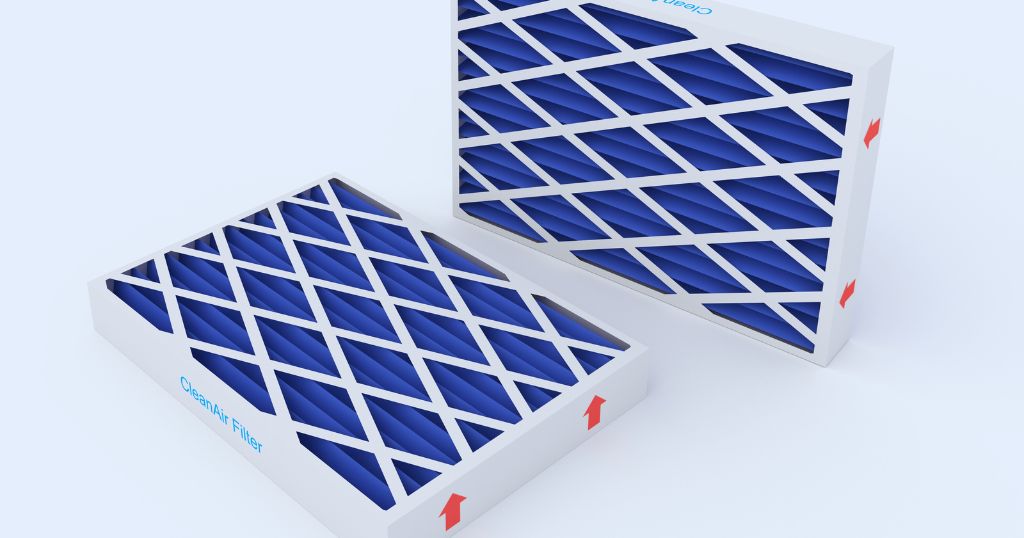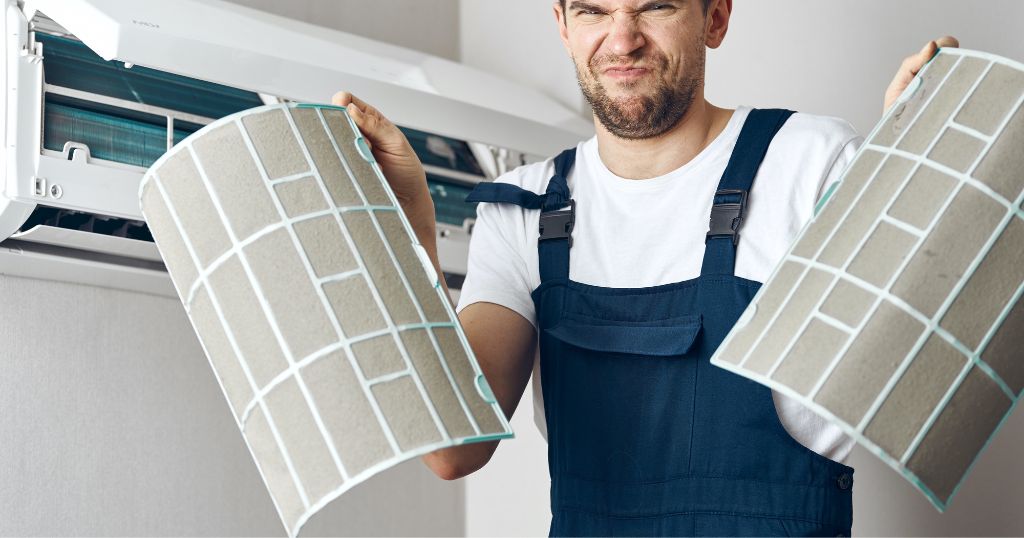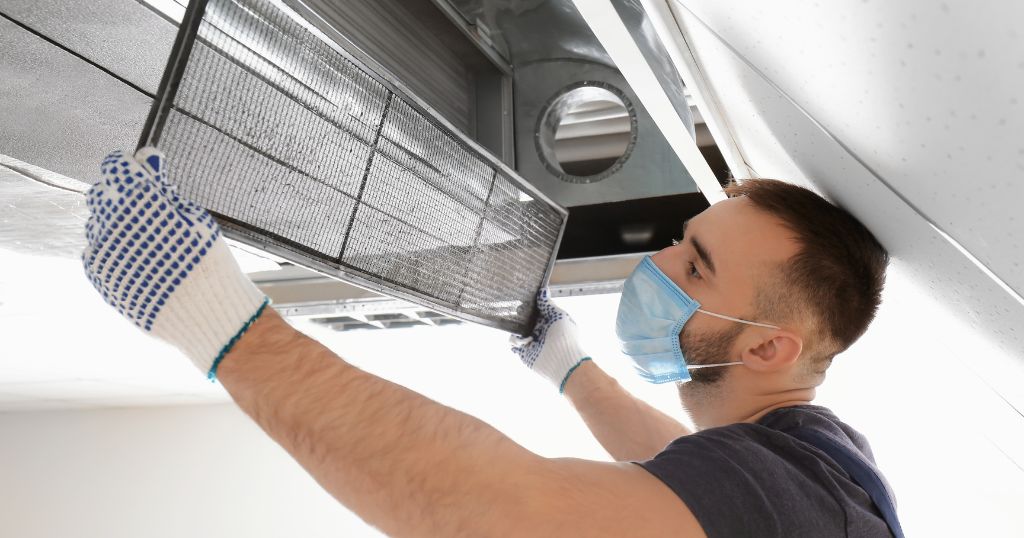Fiberglass vs Pleated Air Filters
Fiberglass vs Pleated Air Filters
Imagine taking a deep breath of clean air at home, free of dust, allergens, and even pet dander. Doesn’t that sound delightful? However, achieving that level of air quality necessitates navigating the often-complex world of air filters. Two names dominate the scene: fiberglass and pleated.
Choosing between them can be like deciphering ancient riddles, leaving you wondering, “Which one can help you maintain your indoor air quality?” If you can relate, worry not, readers!
This blog is a friendly guide that will help you learn the inner workings of these air filters, their strengths and weaknesses, and how to choose the best air filter for your specific needs. So, read this exclusive blog until the end to learn everything about these air filters!
Fiberglass Air Filters

Fiberglass air filters are a popular choice for many homeowners because they are inexpensive and readily available. They serve as the first line of defense against larger dust particles and debris in your home’s air, much like a friendly neighborhood security guard keeping an eye out for unwanted visitors.
Mechanism of Action:
Imagine a thin mesh made of tiny glass fibers, similar to a spiderweb. As air flows through this mesh, larger particles like dust, hair, and lint get trapped in the fibers, preventing them from circulating in your home.
Pros of Fiberglass Air Filters:
- Wallet-friendly: Fiberglass filters are often the most affordable option, making them a good choice for those on a budget.
- Easy to find: They’re readily available in various sizes at most hardware stores and home improvement centers.
- Good airflow: Their open structure allows air to flow through easily, putting less strain on your HVAC system.
Cons of Fiberglass Air Filters:
- Short lifespan: Unlike their pleated counterparts, these filters need to be replaced more frequently, often monthly, to ensure they keep purifying your indoor air.
- Limited filtration: While they capture larger particles, smaller allergens, and pollutants like dust mites and pollen can easily slip through the fibers, offering limited protection for allergy sufferers.
- Not eco-friendly: Fiberglass filters are typically disposable and cannot be recycled, contributing to landfill waste.
Fiberglass Air Filters are Ideal For
If you have a limited budget, a few allergies, and your primary concern is basic dust and debris removal, fiberglass filters may be a good option. However, if you have allergies or are concerned about small pollutants, they may not provide adequate protection.
Remember that while fiberglass filters are initially inexpensive, the need for frequent replacements can result in higher long-term costs when compared to filters with longer lifespans. So, before you make any decision, consider both the cost and the effectiveness factors.
Pleated Air Filters

Fiberglass filters provide basic protection, but pleated air filters are a more advanced shield against airborne invaders. Consider them the highly trained knights in shining armor of the air filtration world, providing superior defense against a broader range of threats. Here’s what makes them different:
Unlike their flat fiberglass counterparts, pleated filters boast a unique design – a pleated fabric surface that expands the overall filtering area significantly. Imagine a long accordion-like structure packed with filter media, providing much more space to capture airborne nasties.
The Perks of Using Pleated Filters:
- Enhanced filtration: Their increased surface area allows superior filtration, capturing not just larger dust particles but also smaller allergens, pet dander, and even some bacteria and viruses. This makes them ideal for allergy sufferers and pet owners.
- Longer lifespan: Pleated filters typically last 2-3 months, significantly longer than the monthly replacements required for fiberglass filters. This translates to less waste and potentially lower overall costs in the long run.
- A wider range of options: Pleated filters come in various MERV ratings, indicating their filtration efficiency. Higher MERV ratings offer even more protection for those with severe allergies or respiratory sensitivities.
Things to Keep in Mind with Pleated Filters
While pleated filters offer amazing protection, there are a few points to consider:
- Price tag: Compared to fiberglass, pleated filters cost more upfront. However, their longer lifespan can balance this out in the long run.
- Airflow: Their thicker design may slightly restrict airflow in some HVAC systems. Make sure your system can handle the chosen filter’s “strength” (MERV rating) without getting overworked.
Who Needs a Pleated Air Filter?
You need a pleated air filter in your home if you:
- Battle allergies: For allergy sufferers, pleated filters provide the best defense against tiny triggers like dust mites and pollen, thanks to their higher MERV ratings.
- Share your home with furry friends: Pet dander? Pleated filters trap it effectively, keeping the air cleaner for everyone.
- Seek ultimate air purity: Pleated filters offer the highest level of protection against various pollutants, making them ideal for those who prioritize superior air quality.
Read More : Complete Guide To Different Types of Home Furnace Filters
Keep in mind that choosing the right air filter depends on your needs and budget. While selecting an air filter for your HVAC, consider the following:
- Allergy level: Higher MERV ratings (8+) offer stronger protection for sensitive noses.
- Pet pals: Dander fighters like pleated filters can be a great choice.
- HVAC compatibility: Ensure your system can handle the chosen filter’s airflow resistance.
- Budget: Balance the initial cost with the longer lifespan and potentially fewer replacements of pleated filters.
By knowing these things, you can confidently choose the air filter that best protects your home and your health! Stay tuned for the final section, where we’ll compare the two filter types and offer helpful recommendations.
Comparison of Fiberglass and Pleated Air Filters

Now that we’ve discussed the benefits and drawbacks of fiberglass and pleated air filters, it’s time for the final showdown! Let’s compare them to see which one works best for improving your home’s air quality.
| Filter Feature | Fiberglass | Pleated |
|---|---|---|
| Price | More affordable upfront | More expensive upfront but potentially cost-effective in the long run due to a longer lifespan |
| Lifespan | Need to be replaced monthly | Last 2-3 months, requiring fewer replacements |
| Filtration Efficiency | Captures larger dust particles | Captures larger dust particles, plus smaller allergens, pet dander, and even some bacteria and viruses (higher MERV ratings offer even better filtration) |
| Airflow | Generally allows for better airflow | May slightly restrict airflow in some HVAC systems (check compatibility with chosen MERV rating) |
| Environmental Impact | Not eco-friendly, typically disposable, and cannot be recycled | More eco-friendly, some are recyclable |
| Ideal for | Budget-conscious homeowners with minimal allergies | Allergy sufferers, pet owners, those seeking superior air quality, and those who prioritize longer lifespans and potentially lower overall costs |
Remember, there’s no one-size-fits-all solution. By understanding the trade-offs between affordability, lifespan, filtration efficiency, and environmental impact, you can make an informed choice that suits your unique needs and budget. Don’t hesitate to consult your HVAC professional for guidance if needed.
Which Type of Air Filter is Right for You?

Now that you’ve compared fiberglass and pleated air filters, it’s time to select the best one for your needs! Remember that the “best” filter depends on your specific priorities and circumstances. This guide will allow you to make an informed decision:
For Those on a Tight Budget:
If cost is your primary concern, fiberglass filters may be an initial option. However, consider their frequent replacement needs, which can result in higher long-term costs. Before you make a decision, weigh the upfront savings against the cost of repeated replacements.
For Those with Allergy Issues and Respiratory Problems:
If allergies or respiratory issues are a priority, pleated filters with higher MERV ratings (8+) provide better protection against tiny allergens such as dust mites and pollen. Their advanced filtration capabilities can improve both your breathing comfort and overall health.
For Pet Owners:
Do you share your home with furry friends? Pleated filters are excellent at capturing pet dander, resulting in cleaner air for everyone. Give your companions (and your lungs) the gift of cleaner, healthier air.
For Those Seeking Optimal Air Quality:
If achieving the purest air possible is your top priority, regardless of cost, pleated filters reign supreme. Their advanced filtration eliminates a variety of pollutants, providing your home with the purest air possible.
Remember:
- HVAC Compatibility: Always ensure your system can handle the chosen filter’s airflow resistance, especially with higher MERV ratings in pleated filters.
- Seek Expert Help: Don’t hesitate to consult your HVAC professional for personalized guidance based on your specific needs and system capabilities.
By considering these factors and using this guide, you’re well-equipped to choose the air filter that becomes the champion of your home’s air quality! Make an informed choice, breathe easy, and enjoy the benefits of cleaner, healthier air!
In Conclusion
Choosing the right air filter for your home can greatly improve the quality of air you breathe and your overall health. For allergy sufferers and those with respiratory sensitivities, higher MERV-rated pleated filters are recommended. Pet owners can benefit from pleated filters as they effectively capture pet dander.
Those who seek the purest air possible can opt for pleated filters with advanced filtration capabilities. It’s important to ensure that the chosen filter is compatible with your HVAC system and seek expert help if needed. By following these guidelines, you can make an informed decision and enjoy the benefits of cleaner and healthier air.
However, if you are still undecided or are looking for high-quality HVAC filters to improve your indoor air quality, you can connect with the experts of Custom Filters Direct for comprehensive assistance. Call us at 1-877-958-5612 today!

 Email Us
Email Us